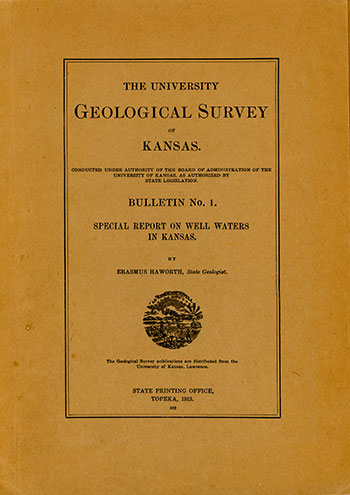Special Report on Well Waters in Kansas
by Erasmus Haworth

Originally published in 1913 as University Geological Survey of Kansas Bulletin 1. This is, in general, the original text as published. The information has not been updated. An Acrobat PDF version (50 MB) is also available.
Letter of Transmittal
Dr. Frank Strong, Chancellor of the University of Kansas:
SIR—I have the honor to submit to you herewith a special report on Well Waters in Kansas, prepared by myself principally. The information herein contained has been gathered gradually throughout the entire period of the existence of this Survey and is here summarized and put into a readable form for the first time. It is prepared hurriedly as an emergency report, due to the great and unparalleled scarcity of water in Kansas this season, particularly in the eastern part of the state, with a desire that it may be distributed throughout the state at the earliest possible moment. It is written expressly for the layman, rather than the scientist, although it is hoped it may not be entirely uninteresting to the latter.
This report will constitute Bulletin No. 1 of the reports of the Geological Survey of Kansas.
Most respectfully submitted.
Erasmus Haworth,
State Geologist.
Lawrence, Kansas, October 1, 1913.
Preface
This Bulletin is written for the layman rather than the scientist, and therefore elementary explanations are given with frequency. The present summer, 1913, has been the dryest summer known for many years. The rainfall has been unusually light. Surface streams of water, springs and wells have gone dry, even to a greater extent than in the unusually dry year of 1901. This extraordinary drouth of the ground is due to a combination of dry weather this summer and the approach to drouths during the three preceding years. The drouth of 1901 was followed by a period of unusually rainy weather, which produced the floods of 1903, 1904, and 1905. Throughout this period the ground became thoroughly saturated with water. Then came a few years of about average rainfall, followed by a period of drouth which came on gradually and increased in intensity up to the present time. It is not the drouth of 1913 alone, therefore, which has made ground water so scarce; but the drouth of 1913 is a culmination of a period of dry years, each one being a little more severe than its predecessor, so that the real dearth of ground water became more noticeable than the actual rainfall might imply.
Another feature of the rainfall, particularly in the eastern part of the state, has enhanced the drouth. During the last two years rains which have come have been more precipitous than usual while they lasted and more local in extent. This has resulted in a larger per cent of the rainfall being disposed of by run-off than the general average for Kansas, and much more than one would at first think possible during such dry weather. For example, during the late summer of 1912. a heavy rain fell in the vicinity of Dexter, severe enough to cause miniature floods along Grouse Creek and its tributaries. It was estimated by local residents that more than four inches of rain fell in some places. The ground was dry and parched and would have absorbed all the rainfall had opportunity been afforded. But the water came in such quantities and so rapidly that time was given for the absorption of only a portion of it, and consequently much of it ran away and did but little good. Heavy, rapid showers are characteristic of dry countries, and usually in any given area, during protracted drouths, the small amount of rain which does fall is more intense than the average rains in the same areas during humid years.
The combination of all these conditions has resulted in making Kansas suffer for want of water for domestic purposes, including stock water, more during the present summer than has been known for a long time. It is well known to this Survey that many parts of Kansas are well supplied with ground water readily available for the asking, so that the scarcity of water need not be nearly so acute as it is, should proper arrangements be made for winning water from beneath the surface. It is also well known that in certain other areas ground water is scarce, or entirely unavailable, and false hopes should not be raised for a good supply in those areas. This little volume is brought out hurriedly in a hope of giving proper information on the subject.
It is recognized, the entire question of water supply includes the use of surface water found in rivers and water which may be impounded in ponds. This latter phase of the water problem is largely, if not entirely, engineering work, taking care of the water after impounded on the surface, and in general, is disconnected from obtaining water from the ground. For various reasons it is thought best to confine this report to ground water, leaving to other departments in the public-service work the task of properly propounding to the people of the state correct methods for handling surface water.
Erasmus Haworth, State Geologist
Kansas Geological Survey, Geology
Placed on web June 9, 2017; originally published 1913.
Comments to webadmin@kgs.ku.edu
The URL for this page is http://www.kgs.ku.edu/Publications/Bulletins/1/index.html